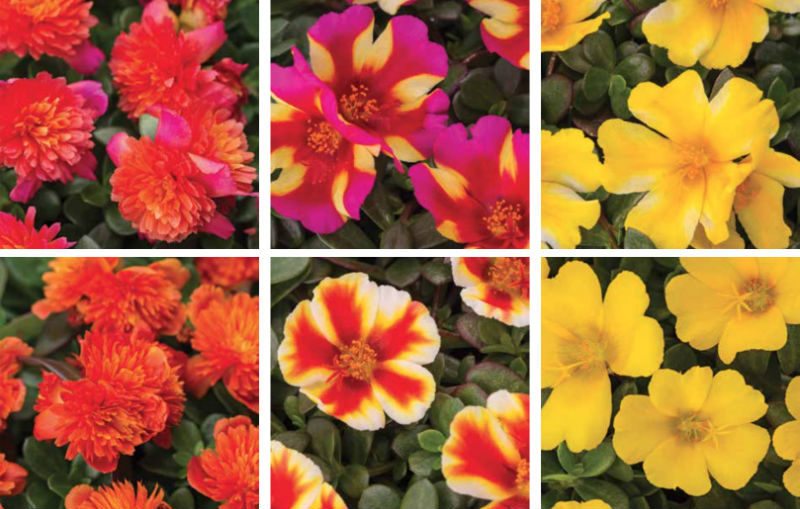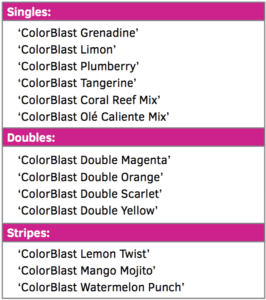
Culture Report: Portulaca ColorBlast Series
The new ColorBlast portulaca from Westhoff set a new standard for drought-tolerant color. From the vivaciously colored single mixes to the explosive fully doubles, to the industry changing stripes, the ColorBlast line is bringing a lot of excitement to garden beds and borders for its low maintenance summertime color.
Trial after trial, this summer showed the ColorBlast series of portulaca to put off the strongest blast of color in any series with flowers that stay open longer than any others under low light conditions and thriving in the summer’s worst heat spells.
The ColorBlast series comes in three sub groups; single colors, doubles and stripes. For the singles, Westhoff recommends doing either of their two mixes to offer consumers a single container with a brilliant blend of neon tones.
Propagation
Portulaca cuttings are very sensitive to ethylene build up during shipping, so it is important to unpack the cuttings immediately so the ethylene can escape. Being a sensitive cutting, portulaca should be one of the first items to stick after your shipment arrives.
As with all succulents, portulaca should be removed from the shipping bag and allowed to sit in open air for one to two hours before sticking. This allows the sap to form a fine “skin” over the end of the cutting before sticking. This will prevent bacteria and fungi from entering the wound during the rooting process.
The soil media for propagation should be well drained and contain a minimum of 40 percent perlite. There is no rooting hormone required for portulaca. To prevent stem rot in the rooting stage, do not pre-wet the rooting media; the rooting media will get enough moisture during the first mist applications. Cuttings often drop a few leaves immediately after sticking due to the transport stress, which is completely normal. The dropped leaves should be removed two to three days after sticking, when no more leaf drop is expected, to prevent the attraction of fungus gnats and Botrytis.
During the first three days after sticking provide a light mist application to rehydrate the leaves and stems. After three days, mist is only required if air moisture drops below 60 percent. Cut mist application three hours before sun down, to avoid wet foliage during night hours.
Ideal temperatures during the rooting phase are between 75 to 80° F, but should never be allowed to drop below 70° F. Light levels during the day should be maintained between 1,800 to 2,200 foot-candles.
During propagation, no fertilizer should be applied to the soil medium. After the first roots are visible on the stems, a first application of 70 ppm can be applied. Irrigation should only be done if soil medium starts drying out. Avoid heavy water applications to prevent root rot of the young root material.
Finishing
Growing media and fertilizer. For best results, use a well-aerated soilless media with 30 to 50 percent of a drainage component such as perlite. Portulaca is a low feed user and the roots are sensitive to soluble salt buildup. The EC and pH should be checked frequently and should be maintained between 600 to 1,400 (EC) with a pH between 5.8 to 6.2.
The roots become more sensitive to salt buildup during warmer summer months and should be monitored regularly. Constant liquid feeds should not be higher than 50 ppm. In the winter months, it can be increased to 75 ppm with less water applications. Allow the media to dry out between waterings to avoid root rot.
Portulaca do not need excessive space for roots, so growers can use shallow containers to save on media and shipping costs, as well as speeding up production times. Excessively deep containers will delay the beginning of top growth and extend the finishing time.
Light. The ColorBlast portulaca are full sun plants and can finish in production under full sun levels, but plants should be cautiously hardened into a full sun environment from propagation to avoid leaf scorch in the first few days after transplant.
Watering. Portulaca are extremely drought tolerant and will easily bounce back from severe dry downs. However, complete drying out should be avoided to reduce the risk of flower drop and delay of top growth. Plants should be given moderate water levels after the pots have dried half way down. Keeping the roots excessively wet will result in root rot in a very short time.
Temperature. Portulaca is a heat-loving plant that will perform best under warm conditions. The optimum temperatures for growth are
80 to 85° F day and 55 to 65° F night. Once optimum top growth has been achieved, night temperatures should be lowered to 45° F to tone the plant tissue and keep the growth habit tight. To get plants to flower for early spring sales, increase night temperatures to 70° F for three weeks before shipping.
Production schedule.
Propagation 84-cell: 5 weeks
Finishing 4-inch: 6 to 8 weeks (1 ppp)
Finishing gallon: 10 to 12 weeks (1 ppp)
12-inch basket: 12 weeks (3 ppp)
Pinching and PGR. Compact plant habits are easily managed through low night temperatures and water management. Chemical growth regulators are not recommended. Pinch the tips before transplant. For bigger containers an additional pinch is helpful before hanging or spacing of the finished container.
Insects and diseases. During propagation, watch for Botrytis and bacteria infections. Preventive Cooper Hydroxide applications are beneficial.
Monitor for root rot throughout propagation and finishing. Preventive root rot fungicide applications are recommended.
Mealybugs can occur during warm and dry weather. Snails and slugs can be an issue during the summer months.










 Video Library
Video Library 


















